Results of a research and information campaign on the possible presence of monk seals on the west coast of Algeria
First recorded instance of a hooded seal (Cystophora cristata) in Algeria
M. Bouderbala, D. Bouras, D. Bekrattou, K. Doukara, M.F. Abdelghani and Z. Boutiba
Laboratoire réseau de surveillance environnementale.
Département de biologie, Faculté des Sciences, Université d’Oran, Algérie.
Introduction
During the summer of 2006, a comprehensive research mission on the Mediterranean monk seal Monachus monachus was undertaken by the Environmental Surveillance Network Laboratory of the University of Oran. The purpose of the mission was to reassess knowledge of this species and to identify critical habitats, with the aim of establishing an action plan for its study and conservation along the Algerian west coast.
1. Mission objectives
Carrying out a systematic exploration of the Algerian west coast (Fig.1); to collect information through surveys directed at various stakeholders in the target area (fishermen, yachtsmen, inhabitants of the coastal communities, and local authorities); to undertake information and awareness-raising activities aimed at the wider public; and finally to set up a Network of monk seal observers.
2. Study area location
The target area for the research campaign is shown in Fig. 1.
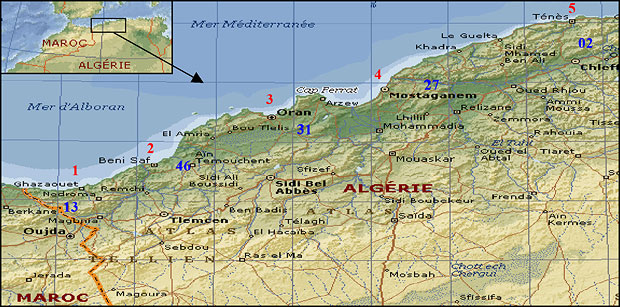
Fig. 1: Study areas (1, 2, 3, 4, 5), and the Wilayas or provinces (02, 13, 27, 31, 46) to which each coastal sector belongs.
3. Data collection, information and awareness raising
a) Survey
During a two month period (15 July-15 September 2006), our Mediterranean monk seal investigations were carried out in various coastal localities in the area of Oran, from Mersat Ben M’hidi in the west, to the Bay of Souahlia, in the east (Fig. 1).
We conducted interviews with more than 850 fishermen (professionals and amateurs working in the area), and with a hundred recreational boatmen who shared with us their observations on the species. This information was supplemented by the testimonies of the maritime authorities (maritime inspectorate, coastguard, civil protection, port authorities, operators of lighthouses and coastal signals), and also the gendarmeries of coastal communities.
During this 60-day research along more than 450 km. of coastline, a public awareness campaign on the problem of the survival of the monk seal in Algeria was undertaken, targeting those directly involved in the maritime professions, our teaching colleagues in the educational community (University related centres of Oran), holiday camps, primary and high-school pupils, and marine protection associations.
Discussions were also held with the teachers of the Schools of Fishing and Aquaculture of the five wilayas, or provinces (Tlemcen, Ain Témouchent, Oran, Mostaganem and Chlef), and with those of the Béni Saf Fisheries Research and Study Centre (Aquarium of the city of Béni Saf, Wilaya de Tlemcen).
During our contacts with the “people of the sea”, teachers, primary- and high-school pupils, and the young people at the holiday camps, we distributed more than 3000 copies of an information and public awareness leaflet, “Let’s save the monk seal”, translated into the two languages (Arabic and French). In the event of a possible observation of a seal, this leaflet provides information enabling direct communication with us, so as to facilitate the collection of relevant information.
Furthermore, following an explanation of their contents, posters (A4 format) were provided to harbourmasters and to the directors of the university centres. A network of voluntary observers was established.
b) Research by land
Coastal areas accessible by land were surveyed irregularly on several occasions. Over a total of 50 days, 250 hours of systematic research (4 – 5 hours on average per day) were devoted entirely to the exploration of the coast. The coastal sectors of the western area were traversed by means of a personal vehicle. Successive stops (10 – 20 minutes each) were performed along beaches, cliff tops and outcrops, approximately every 200-250 meters. Sometimes, when the topography was favourable, a search was made for good observation posts overlooking the sea, allowing use of binoculars (Type: DILUX 7x50: fields of observation = 124m x 1000m), to explore habitat (caves, shelters, crevices, small bays, etc.).
Also, two Canon cameras (a professional EOS 3000; the other a digital IXSUS 30) proved a great help during research, providing a photographic record of our contacts with stakeholders.
c) Sorties at sea
Ten missions at sea were undertaken along coastal zones and islands inaccessible by land or difficult to reach in any other way than by boat. All missions were conducted thanks to the logistical support of the Coastguard, and sometimes with the enthusiastic assistance of certain fishermen, yachtsmen or public organizations, which offered use of their respective vessels for better exploration of the more inaccessible areas.
This also made it possible for us to approach sea caves in order to ascertain whether they are still used by the species.
These missions at sea each lasted between 2 – 6 hours and were all undertaken in calm seas.
4. Results of the research mission
Results obtained during our research by land and sea were unsuccessful in that no monk seal individual was observed directly. “People of the sea” questioned on the presence of the species along these coasts remember this amphibious animal which lived formerly in their fishing areas.
There was no indication of monk seal presence at the time of our expedition in July 2006, and testimonies collected are unanimous in suggesting a disappearance of the species in the extensive coastal sector of the wilayas of Tlemcen, Ain Témouchent, Oran and Chlef (Fig.1).
On the other hand, on the coast of the wilaya of Mostaganem, a great surprise awaited us.
Just as in Macta, the species has not been present in the locality of Stidia (in the west of Mostaganem) for several years, according to the inhabitants of this community. A fisherman informed us of the appearance of a young seal with a length of 1.20m and with a black dorsal colouration in 2000. This information may be accurate because a few hundred meters further east, in the sector of the Macta-Cape Rouge, a seal pup was observed, according to numerous local witnesses.
Two fishermen, whose testimony was considered reliable, informed us that they had directly observed a young seal there fifteen days earlier, along the coast of Stidia. This young animal measured approximately 150cm, according to their statements. We thought it necessary to check this important information and to ascertain whether these two young men did not confuse the species with a dolphin. We also questioned other people at Stidia beach, and the Civil Protection Services of the locality. To our general surprise, all the people questioned on the presence of the seal in this coastal area attest to having observed it swim around Sablettes, located further west.
Arriving at the location, at first we met no one who could confirm to us that the species was present in this area, but were advised to meet a Mr. Rafik, Captain of the fire brigade. At that moment, our young student who accompanied us came running up with young swimming teachers/life guards from Sablettes beach, shouting, "Sir! Sir! The seal was observed about 15 days ago! A photograph of the seal was made by the young life guards, as they carried it on their stretcher!”
Quickly confirming this, the picture turned out to be of a very nice young seal, and it seemed likely that its parents could not be far away. We could only conclude that the species continued to survive in the area!
When we met the Captain of the fire brigade, he related an extraordinary account of events: “During a routine exercise two weeks ago, about 10-11 August, the crew of our speedboat saw from afar a small shadow on the surface of the water. The weather was good and the sea calm, and as we approached we were surprised to find ourselves face to face with a very young seal, weak, alone and in distress! Our spontaneous decision was to collect the seal and take it urgently to a veterinarian in the town of Mostaganem! On shore, many young people ran up, curious to see this mysterious animal which we had collected from the sea, and which had nothing in common with a fish! Very quickly, fishermen brought it fresh sardines to eat. Unfortunately, the seal refused to eat. We decided to evacuate it immediately for veterinary care. Luckily, the veterinarian was present at his surgery and kindly agreed to examine the seal immediately. After some time, he administered multivitamin injections. With the seal showing signs of recovery, it was thought best to avoid further disturbance, and under strict monitoring and other precautions, to release it at a secluded shore far away from human frequentation, so that it would have a greater chance of being found by its parents.”
Figures 3 and 4 show the very young seal discovered astray at sea; figure 5 marks the precise point of its observation, while figure 6 records the extraordinary rescue of this young seal by the Service of Civil Protection (Mr. Rafik and Mr. Rabah); a young fisherman (Mr. Mansour) of Sablettes, and the many who congregated at this happy event to observe the appearance of this young pinniped.
Considering its small size (115cm), and weight (approximately 15kg) it was considered likely that this young seal had become lost, perhaps while daring to stray away from the cave where it must have lived with its mother, a cave perhaps not far from the point of its discovery.
All the research team speculated as to whether this seal was a new-born pup or a very young seal.
On the Algerian coast, Lloze (1979) indicates that the size of newborn pups varies between 100 and 110cm; in contrast, Marchessaux (1989) cites a standard length of 96cm for a male newborn pup on the Algerian coast, and a foetus length of 92cm.
Elsewhere, an infant seal discovered dead in a cave on Cape Lindles, in May 1989, measured 92cm. Another seal pup, found dying in a cave near Bou Zadjar by fishermen in August 1997, measured approximately 95cm and weighed about 13kg. Finally, an infant seal conserved in formaldehyde (ref. mn n°3, CERP, Bou Ismail) verges on 100cm and weighs 12.3kg (Boutiba 1996, 1998 & 2004). On the basis of this evidence might one confidently state that this young seal was already weaned and was hunting on its own, perhaps under the surveillance of its mother or parents?
We returned to the same sector on 27-28 August 2006, surveying the coastline from 06:00 to 19:30, recording the extent of cliffs, caves and crevices both here and also in neighbouring areas.
The seals, however, remained elusive, and were most likely thought to be hiding at the end of some underwater cave nearby. Detecting our presence, they would be certain to leave their shelter directly after our departure, probably at night. That is what we thought most likely at that moment.
Truth be told, our early determining of this young marine mammal as a Mediterranean monk seal was too hasty and based only on a simple examination of the few photographs in our possession, and on the assumption that no other seal species has been recorded in Algeria until now. These photos, in spite of their very weak clarity, were examined later by other experts in Europe* who all either doubted the animal’s identity as a monk seal, or identified it as a hooded seal, Cystophora cristata.
Informed of this new evidence, we set out again to visit the veterinarian who had examined this young mammal in summer 2006, and posed various questions to him about its body, pelage, dentition etc. In response, he recalled various previously unspecified characteristics, including the animal’s spindle-shaped body in keeping with its aquatic environment, a splendid silky fur of a bluish grey on the dorsal side, and white-cream on the ventral.
In the photographs, one clearly sees this colouring, characteristic of the pelage of young hooded seals. Figure 2 clearly depicts cutaneous pigmentations in abundance on the dorsal parts of the body, side and posterior, and an obvious crenulation to the caudal section of the animal.
Aware only of the existence of a single seal species in the Mediterranean, and of the literature confirming that fact, to us this young seal could be only be a single Monachinae.
However, the morphological differences largely distinguish these two species. In the photographs, we can clearly observe that the head of the seal in question is small and round in form, presenting a profile in which there is continuity between the cranium and the muzzle. The face is smaller, with a forehead only slightly elevated, presenting brow ridges only a little pronounced. This face surmounts a rather short muzzle, slightly convex at the end, where two nostrils open forming a kind of heart shape, divided into two equal parts by the nasal partition.
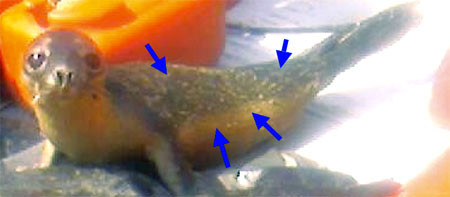 |
|
Fig. 2. Distinguishing marks appearing on the body of the young hooded seal.
|
Hooded seals Cystophora cristata, of the circumpolar seas, are thus named because of the presence of a hood or “cap”, on top of the snout, very well developed in adult males, that can be inflated when the animal is excited, or disturbed by humans.
This nasal hood when uninflated takes the form of a loose, wrinkled sack (Robineau 2004).
It is known that adult male hooded seals measure on average 230cm (standard length) and weigh approximately 250kg (Orisland 1959, Rasmussen 1960, Whg 1985). Their maximum size is 283cm, with a weight of 435kg. The smaller females measure on average 200cm and weigh approximately 180kg, and they can reach 229 cm and a weight of 252kg (Robineau 2004). The length at birth varies between 87-115cm (average 100cm) (Rasmussen 1960, Bowen et al. 1985). The size is 98-118cm (average 110cm) at the time of weaning, and reaches 125-130cm at the end of the first year (Whg 1985). In view of this bibliographical data, and the approximate size of 115cm of the young stray seal, it can be concluded that its age would not have exceeded one year.
The idea that a hooded seal, living thousands of kilometres away, could reach the southwestern coasts of the Mediterranean and, in particular, the coasts of Algeria never occurred to us.
Indeed, the hooded seal normally frequents the Arctic and subarctic areas of the Atlantic. Breeding takes place in March-April on the ice in well defined areas: in the northeast of Newfoundland (to a lesser extent in the Gulf of St. Lawrence), in the Davis Strait (63-64°N) in the west, and the northwest of Jan Mayen (71-73°N) in the east. After breeding, the seals disperse at sea in the Davis Strait and Baffin Bay in the west, and between the south of Greenland and Spitsbergen in the east. However, they return to the ice in June-July to moult. In the northeast Atlantic, strong concentrations of seals are observed during this season, with most recorded in the southeast of Greenland (65-67°N) (Robineau 2004).
It is thought that the individuals who reproduce in the northwest of Jan Mayen principally frequent the waters between the northeast of Greenland, Iceland and Spitsbergen (Kapel 1992). The species is sometimes encountered outside its normal distribution range, for example along the Norwegian coast, around the Faroe Islands, the British Isles, and along the coasts of continental Europe, from Denmark to Portugal. The 34 errant specimens counted by Van Bree (1997) along western European coasts, were principally young individuals of less than 1 year (3 only were older than 1 to 2 years, and only 2 were subadults or adults).
Cystophora cristata is the Arctic species most frequently encountered along French coasts. Twenty-four strandings have been recorded: 5 in the English Channel-North Sea area, 3 in Brittany, and 16 along the Atlantic coastline (Robineau 2004). The number of strandings of this species was exceptionally high in the year 2001 (Van Canneyt 2002). Also, hooded seal strandings have been numerous on the Portuguese and Spanish coasts (Toni Font, pers. comm. 2007). It is possible that this young hooded seal travelled from the coasts of the north Atlantic, passed through the Straits of Gibraltar and followed the strong marine currents through the Sea of Alboran, until it stranded along the Algerian west coast.
Conclusion
This expedition enabled the gathering of information on the population of monk seals along the west coasts of the country (the Algerian-Moroccan border in the west, to the departmental limit of Daira de Ténès in the east, 150km from Algiers) (Fig. 1); it was also used to inform and sensitise the general public, and to set up a Regional Network of Voluntary Observers for the Monk Seal along the Algerian west coast.
The results are of little comfort. Indeed, the Mediterranean monk seal Monachus monachus, while formerly present in some coastal areas less frequented by humans, now seems to have deserted even those places since some time.
The discovery of a young seal, 115cm in length and weighing approximately 15kg, initially spoke in favour of the survival of at least a reproductive couple, and possibly of a group of seals, living very discreetly in the vicinity of where this young seal was found. On the basis of new data, however, it was found that this young seal had no connection with M. monachus, but was an accidental visitor, a pinniped belonging to the Arctic seals of the genus Cystophora (Nilson, 1820) and to the species known as the hooded seal, Cystophora cristata (Erxleben, 1777).
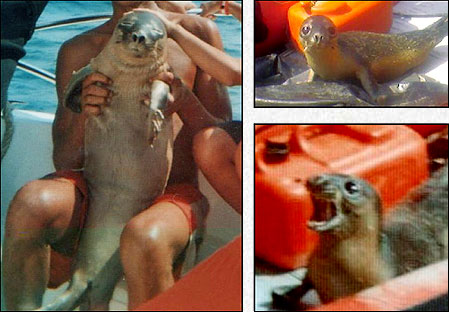 |
|
Fig. 3. The young hooded seal Cystophora cristata discovered at Sablettes (Wilaya de Mostaganem).
|
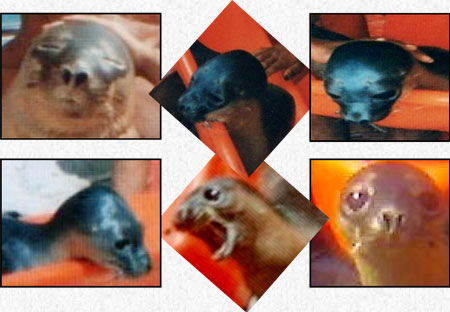 |
|
Fig. 4. Various profiles of the head of the young hooded seal at Sablettes (Wilaya of Mostaganem).
|
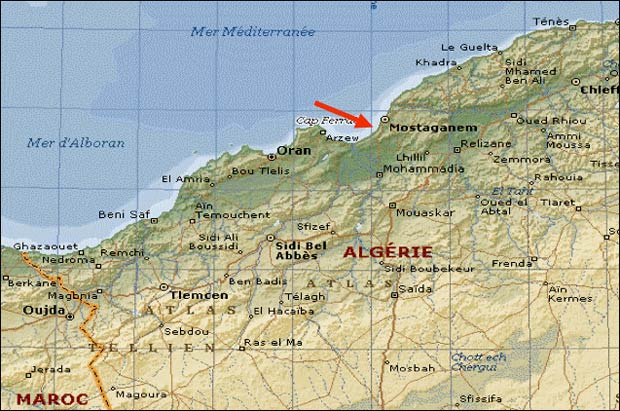
Fig. 5. The red arrow indicates the place where the young hooded seal Cystophora cristata was discovered in Sablettes on the Mostaganem coast.
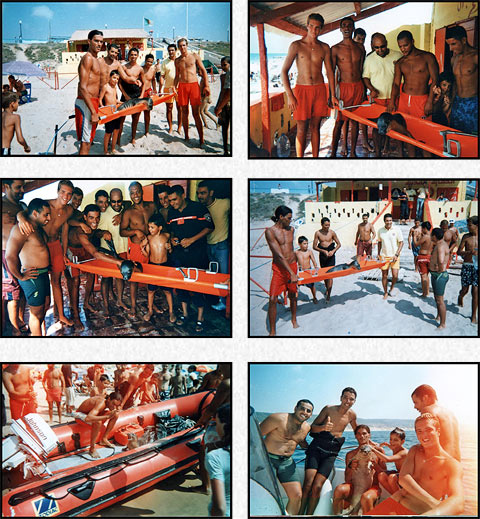 |
|
Fig. 6. Scenes from the rescue of the young hooded seal Cystophora cristata at Sablettes (Wilaya de Mostaganem).
|
*Acknowledgements
The authors offer their sincere thanks to the following specialists who played a crucial role in determining the identity of the seal species found stranded along the Algerian coast as Cystophora cristata, rather than Monachus monachus as first thought: Luis Mariano González (Fundación CBD-Hábitat, Spain), Manel Gazo (Fundació CRAM, Spain), Matthias Schnellmann (TMG), William M. Johnson (TMG), Toni Font (Pandion, Spain), and Jeny Androukaki (MOm, Greece).
References
Boutiba Z. 1992. Les Mammifères marins d'Algérie. Statut, Répartition, Biologie et Ecologie. Thèse Doct. Etat: 575p.
Boutiba Z. 1996. Disappearing species: the case of the monk seal in Algeria. In W.D. Swearingen & A. Benchérifa (eds.). The north African environment at risk. Westview Press, Boulder, CO: 191-204.
Boutiba Z. 1998. Biodiversité marine en Méditerranée du Sud-Ouest. Revue Internationale Medondes. Edit. PNUE No. 37: 14-15.
Boutiba Z. 2004. Les derniers phoques d’Algérie. Ed. Dar El Gharb (Oran- Algérie): 228p.
Boutiba Z. 2004. Le phoque moine d’Algérie. In Grimes et al., Biodiversité marine et littorale Algérienne. Ed. Sonatrach. Ed. Diwan, Alger. 362p.
Bowen W.D., O.T. Oftedal and D.J. Bones. 1985. Birth to weaning in four days: extraordinary growth in the hoodead seal, Cystophora cristata. Can. J. Zool. 63: 2841-2846.
Kapel F.O. Cystophora cristata (Erxleben, 1777). Klappmutze. In R. Duguy et D. Robineau D. (ed.). Handbuch der Saugetiere Europas 6, 2, Aula Vg., Wiesbaden: 225-249.
Orisland T. 1959. Klappmys. Fauna 2: 70-90.
Rasmussen S. 1960. Om klappmyssbestanden i det nordlige Atlanthav (On the stock of hooded seals in the northern Atlantic). Fisk. Hav. 1: 1-23.
Robineau D. 2004. Faune de France 88. Fédération française des Sociétés de Sciences naturelles. 199p.
Van Bree P.J.H. 1997. On extralimital records of hooded seals, Cystophora cristata (Erxleben, 1777), on the western European continental coast. Z. Saugetiere 62: 182-186.
Van Canneyt O. 2002. Les échouages de mammifères marins sur le littoral français en 2002.- CRMM-MEDD: 38p.
Whg O. 1985. Multivariate variation in the hooded seal (Cystophora cristata). J. Zool., London 206: 407-508.
|








